|
|
| |
VTC
Training for Gas Installers
Gas installers are the key
to gas safety: working on the front-line, they ensure that appliances
are correctly fitted and remind users of proper usage and maintenance
procedures. Even before the Gas Safety Ordinance was enacted,
the Gas Standards Office (GasSO) saw an urgent need for standardised
training of these skilled workers, and made the necessary arrangements
with the Vocational Training Council (VTC).
To date, the Council has
trained thousands of gas installers to carry out installation
work in accordance with Hong Kong conditions and codes of practice,
and international standards. It now also provides training for
LPG vehicle mechanics. |
|
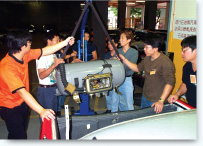 |
 |
|
| |
Codes
of Practice and Guidelines
The development of codes of
practice and guidelines has been crucial to achieving the standardisation
of work and widespread adherence to the best practices that characterise
the local gas industry today.
GasSO started to develop codes
of practice and guidelines in conjunction with the launching of
the VTC training, both in the mid-1980s. To date, we have 24 codes
of practice and guidelines in use.
|
|
 |
 |
|
| |
Balanced
Flue Gas Water Heaters
Balanced flue gas water heaters
were introduced in the early 1980s to replace flueless gas water
heaters in bathrooms after the latter claimed several lives in
1979 as a result of carbon monoxide poisoning.
The use of the much safer balanced
flue water heater was reinforced by an amendment to the Buildings
Regulations in 1983, which mandated a flue aperture in all bathrooms
of new residential flats. The result was a dramatic reduction
of gas incidents in the bathroom.
|
|
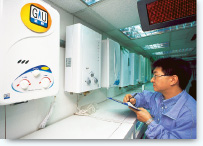 |
 |
|
| |
Flexible
Gas Tubing Standards
A number of incidents in the
early 1980s alerted us to the need to prohibit use of unsafe gas
tubing. We studied standards from many countries and consulted
with the trade to develop a set of standards for Hong Kong for
flexible gas tubing, which became mandatory in the mid-1980s.
This was another major step
towards eliminating the root cause of many of the gas incidents
that occurred in the early days.
|
|
 |
 |
|
| |
Approval
of Domestic Gas Appliances
The years since 2000 saw many
improvements in the regulation of gas appliances. Among the most
important was the introduction, in 2002, of the mandatory “Approval
of Domestic Gas Appliances” under the Gas Safety Ordinance.
This requires that all domestic gas appliances sold in Hong Kong
must be approved by the Gas Authority. Approved appliances carry
the GU Mark to signify they have been manufactured in accordance
with international safety standards and local operating requirements.
The GU Mark has become a mark
of consumer confidence when it comes to gas appliance purchase.
|
|
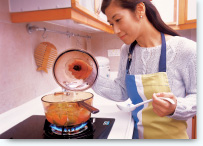 |
 |
|
| |
Flame
Failure Devices
During the 1980s, a number
of Hong Kong householders experienced gas incidents when a draught
blew out the flame on their gas stoves, resulting in gas leakage.
In response, we engaged the trade to widely introduce gas cooking
appliances fitted with flame failure devices. This requirement
eliminated the cause of such incidents and also made the device
much more affordable for consumers through the economy of scale
thus created.
As a result, flame failure
incidents have rapidly declined since the 1990s. The enactment
of the mandatory domestic gas appliance approval requirement in
2002 made it compulsory for all gas cooking appliances to be fitted
with such safety devices.
|
|
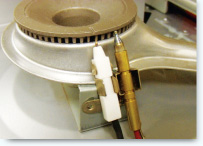 |
 |
|
| |
Excess
Flow Valves
LPG cylinder regulators and
relatively new supply points of piped gas installations are fitted
with an excess flow valve, which automatically cuts off the gas
supply under abnormal conditions such as leakage of gas. This
safety feature was introduced in the 1990s and brought about a
reduction in gas leakage incidents, especially those in connection
with LPG cylinder installations.
The fitting of excess flow
valve on the LPG fuel supply system is also one of the key safety
design features of LPG vehicles used in Hong Kong.
|
|
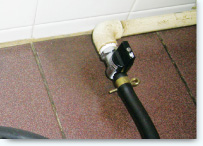 |
 |
|
| |
Additional
Safety Measures for LPG Road Tankers
The safety requirements for
LPG road tankers are particularly stringent, given the hazards
of transporting flammable substance in bulk.
In 1991, we mandated additional safety measures, including the
installation of an engine overrun prevention device, and a device
to cut off the fuel supply to the engine in an emergency. In addition,
all LPG road tankers in Hong Kong must be coated with a fire resistant
material that provides protection against explosion for up to
an hour under a pool fire situation.
|
|
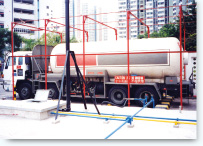 |
 |
|
| |
LPG
Taxi Scheme
The LPG taxi trial was launched
in 1997 to help alleviate air pollution in Hong Kong. With its
success, the Policy Address 1999 announced that financial assistance
would be provided for taxi owners to replace their diesel taxis
with LPG vehicles. To support the refilling of LPG taxis, the
first batch of dedicated LPG filling stations was commissioned
in 2000.
Today almost all the 18,000
taxis in Hong Kong run on LPG. The fleet is well supported by
a territory-wide infrastructure of LPG filling stations and trained
mechanics. A similar scheme to encourage light buses to switch
from diesel to LPG was introduced in 2002. Some 2,900 LPG light
buses are now on the road. |
|
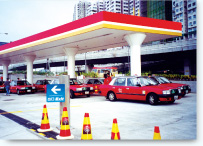 |
 |
|
|

